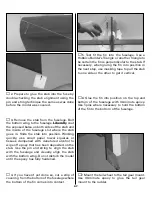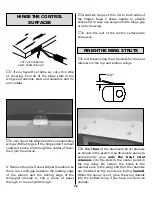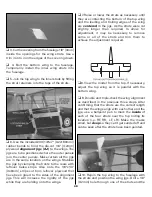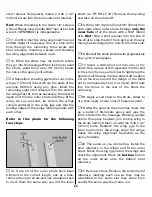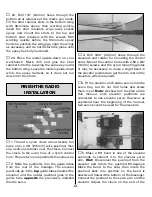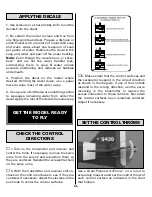
2. I will not fly my model aircraft in the presence
of spectators until I become a qualified flier,
unless assisted by an experienced helper.
3. I will perform my initial turn after takeoff
away from the pit or spectator areas, and I will
not thereafter fly over pit or spectator areas,
unless beyond my control.
4. I will operate my model using only radio
control frequencies currently allowed by the
Federal Communications Commission.
Since the S.E.5a qualifies as a “giant
scale” model and is therefore eligible to
fly in IMAA events, we’ve printed excerpts
from the IMAA Safety Code which
follows:
Definition
For the purpose of the following IMAA Safety
Code, the term “Giant Scale” shall refer to radio
controlled model aircraft, either scale or non-
scale, which have a wingspan of 80 inches or
more for monoplanes and 60 inches or more for
multi-winged model aircraft and have a ramp
weight (fueled and ready to fly) of 55 lbs.
or less.
Section 1.0: SAFETY STANDARD
1.1 Adherence to Code: This safety code is to be
strictly followed
1.2 The most current AMA Safety Code in effect
is to be observed. However, the competition
sections of the code may be disregarded.
Section 3.0: Safety Check
3.4 Flight Testing: All Giant Scale R/C aircraft are
to have been flight tested and flight trimmed
with a minimum of six flights before the model
is allowed to fly at an IMAA Sanctioned event.
3.5 Proof of Flight: The completing and signing
of the Declaration section of the Safety
Inspection form by the pilot (or owner) shall
document as fact that each aircraft has been
successfully flight-tested and proven airworthy
prior to an IMAA event.
Section 6.0: Radio Requirements
6.1 All transmitters must be FCC type certified.
6.2 FCC Technician or higher-class license
required for 6 meter band operation only.
❏
1.
Fuelproof all areas exposed to fuel or
exhaust residue such as the engine
compartment, radio compartment inside
the fuselage and the fuel tank compartment.
❏
2.
Check
the
C.G.
according
to
the
measurements provided in the manual.
During the last few moments of preparation
your mind may be elsewhere anticipating the
excitement of the first flight. Because of this,
you may be more likely to overlook certain
checks and procedures that should be
performed before the model is flown. To help
avoid this, a checklist is provided to make
sure these important areas are not
overlooked. Many are covered in the
instruction manual, so where appropriate,
refer to the manual for complete instructions.
Be sure to check the items off as they are
completed (that’s why it’s called a
check list!)
CHECK LIST
IMAA SAFETY CODE
(excerpt)
60
Summary of Contents for Dynaflite S.E.5a
Page 9: ...9 Die Drawing...
Page 10: ...10 Die Drawing...


